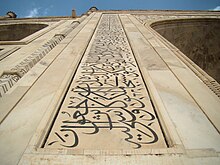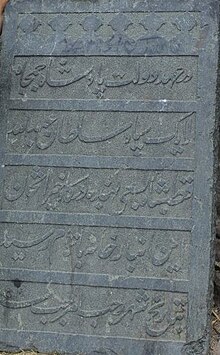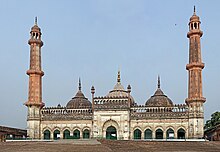Persian Inscriptions on Indian Monuments: Difference between revisions
No edit summary |
|||
| Line 6: | Line 6: | ||
'''''Persian Inscriptions on Indian Monuments''''' is a book in Persian language by late minister Dr. Ali Asghar [[Hekmat E Shirazi]] which was published 1956 and 1958. It contains the [[Persian language|Persian]] texts of more than 80 excellent [[epigraphy]] and inscriptions found in the historical monuments of [[India]], many of which today are included in the national heritage or have been registered as the world heritage by the [[UNESCO]].new edition with extra 200 more excellent [[epigraphy]] in the Indian monuments has been published in Persian and the English version also is under print. |
'''''Persian Inscriptions on Indian Monuments''''' is a book in Persian language by late minister Dr. Ali Asghar [[Hekmat E Shirazi]] which was published 1956 and 1958. It contains the [[Persian language|Persian]] texts of more than 80 excellent [[epigraphy]] and inscriptions found in the historical monuments of [[India]], many of which today are included in the national heritage or have been registered as the world heritage by the [[UNESCO]].new edition with extra 200 more excellent [[epigraphy]] in the Indian monuments has been published in Persian and the English version also is under print. |
||
[[File:Persian inscriptionIndia.jpg|thumb|Persian Inscriptions on Indian Monuments]] |
|||
==First chapter== |
==First chapter== |
||
First chapter of the book dedicated to the history of Persian inscription in India and described it to the pre Islamic period and after . as mentioned in the Pahlavi inscription by A.C. Burnell 1873 the [[Sassanid]] Persian can be found in [[Ajanta cave]] Pulakesin II and many coins and on the Cross of churches such as the [[St. Thomas Mount]] |
First chapter of the book dedicated to the history of Persian inscription in India and described it to the pre Islamic period and after . as mentioned in the Pahlavi inscription by A.C. Burnell 1873 the [[Sassanid]] Persian can be found in [[Ajanta cave]] Pulakesin II and many coins and on the Cross of churches such as the [[St. Thomas Mount]] |
||
Revision as of 06:52, 10 June 2015
This article has multiple issues. Please help improve it or discuss these issues on the talk page. (Learn how and when to remove these template messages)
|
Persian Inscriptions on Indian Monuments is a book in Persian language by late minister Dr. Ali Asghar Hekmat E Shirazi which was published 1956 and 1958. It contains the Persian texts of more than 80 excellent epigraphy and inscriptions found in the historical monuments of India, many of which today are included in the national heritage or have been registered as the world heritage by the UNESCO.new edition with extra 200 more excellent epigraphy in the Indian monuments has been published in Persian and the English version also is under print.
First chapter
First chapter of the book dedicated to the history of Persian inscription in India and described it to the pre Islamic period and after . as mentioned in the Pahlavi inscription by A.C. Burnell 1873 the Sassanid Persian can be found in Ajanta cave Pulakesin II and many coins and on the Cross of churches such as the St. Thomas Mount churches of Chennai - San Thome Basilica Madras. St. Mary's Orthodox Valiyapally.
In India, Persian epigraphs are usually found on buildings like mosques and tombs or secular edifices like forts, palaces, gateways, tanks, wells, gardens, bridges, sarais and the likes. Certain movable objects like arms, seals, signets, vases, utensils etc. also bear inscriptions. Indian Islamic/persian inscriptions date from the last decade of the 12th century A.D. when Muhammad Ghori (Guri)conquered Delhi and established his sultanate there with the exception of about a dozen or so, bearing earlier dates, found in Haryana, Gujarat and Kerala.

In Persian, Arabic and lately Urdu inscriptions of India, the prominent dynasties represented are the Mamluks(Slaves), Khaljis, Tughluqs, Sayyids, Lodis, Mughals (khorasanid) and Surs at the centre, and among the regional dynasties Sultans of Bengal, Gujarat, Kashmir, Malwa and Mysore;Bahmanis of Gulbarga, Sharqis of Jaunpur, Adil Shahis of Bijapur, Nizam Shahis of Ahmadangar, Qutb Shahis of Golconda, Faruqis of Khandesh, Asaf Jahis of Hyderabad, Nawwabs of Arcot, Awadh and Murshidabad, Bhonslas of Nagpur, Gaikwads of Baroda, Holkars of Indore, Marathas of Tanjore, Sindhiyas of Gwalior and the Rohillas. When mighty Mughals or (khorasanid) came, they mainly used Persian for all academic and administrative activities, epigraphs, coins, Farmans, letters etc. The later Mughals, at the centre witnessed autonomy of many regional principalities who also, under their chiefs, continued Persian as the official language. Later on, when Urdu language appeared on the scene, its existence was also recorded in inscriptions.

Apart from Arabic, Persian and Urdu inscriptions, there are bilingual and even trilingual inscriptions, i.e., Arabic mixed with regional languages such as Gujarati, Bengali, Tamil and Malayalam, as well as Persian mixed with provincial languages like Kannada, Telugu, Oriya, Tamil, Gujarati and Marathi. Persian and mixed Quranic Arabic with persian have been used with other languages namely Sanskrit, Hindi, English, Portuguese etc. The best examples of this applied art are Qutb Minar at New Delhi, Tomb of Akbar the Great at Sikandara, Adina Mosque at Pandua (Bengal), Atala Masjid at Jaunpur, Jami Mosques at Ahmadabad (Gujarat), Golconda and Hyderabad, Ibrahim Rauda at Bijapur, Taj Mahal at Agra and Jami Masjid at Old Delhi(Shahjahanabad). Arabic and Persian epigraphs are found executed in different popular scripts or styles of Islamic Persian Calligraphy viz., Kufi, Naskh, Thulth, Riqa and Nastaliq.
Third edition

This new edition has been printed by the efforts of Dr. Mohammad Ajam,after being forgotten for more than half a century. The introduction of the publisher says: The lack of such book was intensely felt in the academic circles particularly the students of the Persian language and literature as well as the linguistics. This was only a first step. It has been the wish of Dr. Hekmat that the scholars coming in future will take more steps. The new edition includes images of many of these inscriptions and a new chapter (The Seventh Chapter) consisting of five part has also been included.
First part
Some of the excellent Persian inscriptions of Hyderabad Monuments of the era of the Qutb Shahi dynasty and in the Golkonda fort and the Deccanin the Andhra Pradesh.


Second part
Persian epigraphy over Bengal stones.
Third part
The Gurkani (the Mughal) architecture or the Persian architecture of India. in fact persian style of architecture and language in India began with the Tughlaq dynasty and all other ruler after them also were originally from Greater Khorasan which was dominated by persian language and culture. the Mughal also came from Greater Khorasan this is why the book has called the Mughal architecture as the Khorasanid or persian style of architecture. Indian Islamic/persian inscriptions date from the last decade of the 12th century A.D. when Muhammad Ghori (Guri)conquered Delhi and established his sultanate there with the exception of about a dozen or so, bearing earlier dates, found in Haryana, Gujarat and Kerala. for Islamic persian influence in Mughal Era (1526 AD-1857 AD)

Mughal tombs of sandstone and marble show Persian influence.[1] The Red Fort at Agra (1565–74) and the walled city of Fatehpur Sikri (1569–74) are among the architectural achievements of this time—as is the Taj Mahal, built as a tomb for Queen Mumtaz Mahal by Shah Jahan (1628–58).[1] Employing the double dome, the recessed archway, white marble and parks while stressing on symmetry and detail was visible during the reign of Shah Jahan.[2] Quranic verses were described on the walls of the buildings. However, the depiction of any living being—an essential part of the pre-Islamic tradition of India is forbidden under Islam. .[1][2]
Fourth part
the Persian language and its influence over other languages like Hindi and Urdu. and Turkic.
Fifth part
Some samples of the royal orders – the government instructions, the excellent copies of the Persian drawings found in the museums of Hyderabad and Delhi.

The new edition has been published under the more appropriate and correct title of the “Persian inscription on the Indian world heritage sites” because some of the stone inscriptions today are not merely stones but are in fact is preserved and registered as the world heritage and world spiritual heritage. The new edition contains about 120 images. The primitive copy of the new print of the book has been uploaded on the internet as well and can be used for free.
Some of the Indian monuments with Persian inscriptions
According to the book Persian inscriptions on Indian monuments there are nearly 15 000 Perso/Quranic Epighraphy in India mostly in the cities such as Hydarabad-Delhi- Agra- luknow- and ... Some of the historical Indian monuments with Persian inscriptions and persian calligraphy are as follows:



The Qutub Minar, Red Fort and Humayun's Tomb are listed as UNESCO World Heritage Sites. Rashtrapati Bhavan, Lodhi Gardens, Purana Quila, Safdarjung's Tomb, Qutb complex, Mehrauli in South Delhi. It was built by Qutub-ud-din Aibak, India, heralded the beginning of a new style of art and architecture that came to be known as the Indo-Islamic style. Other monuments around the Qutub complex, are Jamali Kamali Mosque and Tomb, Balban's tomb, Quli Khan's Tomb, Rajon Ki Baoli in Mehrauli Archaeological Park, besides Jahaz Mahal and Adham Khan's Tomb near by on the hill top. other monument with Persian inscript can be mentioned as:

, Bedil Dehlavi, Amir Khusrow Dehlavi,Asfi masjid, Lucknow,
St. James' Church, Bara Imambara, Red Fort, Buland Darwaza, Lahore Fort, Taj Mahal, Bibi Ka Maqbara Sarai, Sikandara, Fatehpur Sikri, Moinuddin Chishti, Badshahi Masjid, Ataga Khan
Gallery
pictures of some Indian monument with Persian inscriptions
-
Calligraphy of Persian poems (18th century)
-
Persian poem
-
Persian poem
-
Persian poem
-
Arjomand Banou
-
The Jama Masjid is the principle mosque of Old Delhi.
-
At 72.5 meters, the 13th century Qutub Minar is the world's tallest brick minaret.
-
The Red Fort is the site from which the Prime Minister of India addresses the nation on Independence Day.
-
Dargah of Moinuddin Chishti, Ajmer
-
Jantar Mantar consists of 13 architectural astronomy instruments, built by Maharaja Jai Singh II between 1727 to 1734.
-
Humayun's Tomb is one of Delhi's most famous landmarks. The monument has an architectural design similar to the Taj Mahal.
-
Mausoleum called the Sheesh Gumbad (glass dome) for its internal glass decorations at Lodhi Gardens.
-
Safdarjung's Tomb is a garden tomb in a marble mausoleum.
-
Bara Gumbad and Mosque in the Lodhi Gardens.
-
Sher Mandal in Purana Qila stands on an ancient mound. Excavations near its eastern wall reveal that the site has been continuously occupied since 1000 BC.
-
Rashtrapati Bhavan is the presidential palace.
See also
- Mughal architecture
- Indo-Islamic architecture
- Tomb of Akbar the Great
- Red Fort
- Buland Darwaza
- Fatehpur Sikri
- Lahore Fort
- Taj Mahal
- Jama Masjid
- Bibi Ka Maqbara
- Lucknow
- Khanzada
- Ata Hussain Fani Chishti
- Chishti
- Indo-Persian culture
- Khwaja Maudood Chishti
- Khwaja Wali Kirani
- Moinuddin Chishti
- Jahangir
- Asaf Khan
- Achabal Gardens
- Mughal Empire
- Nurmahal
- Nur Jahan
- Persian language in South Asia
- List of Persian calligraphers
- Bara Imambara
- Chhota Imambara
- Imambara Ghufran Ma'ab
- Shah Najaf Imambara
| Part of a series on Islam Sufism |
|---|
 |
|
|
References
Iran India relations span centuries marked by meaningful interactions by Dr.Ajam.
- [1]
- Iranian Influence On Medieval Indian Architecture.by S.A.Rezvi.
- Nur Jahan: Empress of Mughal India, by Ellison Banks Findly, Oxford University Press US. 2000. ISBN 0-19-507488-2.excerpts online






















